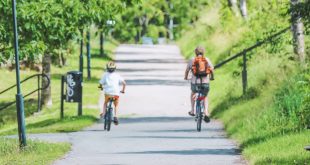While Team GB is brimming with cycle talent in time for the London 2012 Olympic Games, Sustrans has warned that a less active population could harm the chance of growing future champions.
According to research from Bristol University, children who are allowed to get around without adult supervision are more physically active than those who are not. Meanwhile, a YouGov poll on behalf of Sustrans shows a quarter of parents cite traffic speed as the main concern when allowing ten-year old children to get around on their own – reducing the chance for them to saddle up, walk or just be outside. In turn that is increasing the chance of damaging health, confidence and good habits for later life.
Thirty years ago 80 per cent of seven and eight year olds walked or cycled to school on their own. Now that figure is reversed – eight out of ten children in that age range are accompanied by an adult – increasing in a car.
The University of Bristol’s Dr Angie Page, reader in physical activity and public health, said: “Our research measures how young people use their neighbourhoods for getting around and there is strong evidence to show the important role local streets play in getting children active. Children are five times more active outdoors than indoors and children spend the majority of their time outdoors on the streets. Those children who regularly walk or cycle spend more time outdoors compared to those driven by car. So we need work to make sure our streets are safer for children to travel independently otherwise they will lose an important opportunity to gain crucial physical activity.”
Sustans has launched a ‘Free Range Kids’ campaign to tackle the subject. Aims includes a default speed limit of 20 mph where people live, shop and work.
Malcolm Shepherd, Sustrans’ chief exec, said: “We need to ensure our young people get every opportunity to be physically active whether they eventually become Olympic competitors or simply fit and healthy adults. Our own research shows that people are more likely to cycle as adults if they started as children.
“We know that one way to get children out on their bikes and walking is to create high quality routes. We calculate that last year children made 61 million walking and cycling journeys on the National Cycle Network. Yet cuts to transport budgets means less money is being spent on improving the transport systems that most benefit young people.
“With more targeted investment of existing transport budgets we can get children out and about, travelling actively and experiencing the independence they crave. The environment that encourages this – less traffic and more attractive safer streets – is also good for others, especially those most vulnerable members of the community such as elderly people.”
PIC CREDIT: Phil O’Connor
 BikeBiz Bicycle and cycling retail news
BikeBiz Bicycle and cycling retail news



